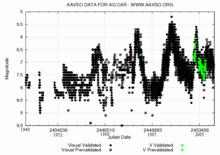AG Carinae
| Observation data Epoch J2000 Equinox J2000 | |
|---|---|
| Constellation | Carina |
| Right ascension | 10h 56m 11.57699s[1] |
| Declination | −60° 27′ 12.8056″[1] |
| Apparent magnitude (V) | 6.96[2] |
| Characteristics | |
| Spectral type | LBV |
| U−B color index | –0.58[2] |
| B−V color index | +0.61[2] |
| Variable type | LBV[3] |
| Astrometry | |
| Proper motion (μ) | RA: −5.89[1] mas/yr Dec.: +2.45[1] mas/yr |
| Parallax (π) | 0.40 ± 0.22[4] mas |
| Distance | 6,000[5] pc |
| Absolute magnitude (MV) | ~-8 (at minimum)[6] |
| Details | |
| Mass | 55[5] M☉ |
| Radius | 50-500[7] R☉ |
| Luminosity | 1.5 × 106[8] L☉ |
| Temperature | 8,000-26,000[7] K |
| Rotation | 13 ± 2[8] days |
| Rotational velocity (v sin i) | 220 ± 50[8] km/s |
| Other designations | |
| Database references | |
| SIMBAD | data |

AG Carinae (AG Car) is a star in the constellation Carina. It is classified as a luminous blue variable and is one of the most luminous stars in the Milky Way. The large distance (20,000 light-years) and intervening dust mean that the star is not usually visible to the naked eye; its apparent brightness varies irregularly between 5.7m and 9.0m.
The star is surrounded by a nebula of ejected material at 0.4-1.2pc from the star. The nebula contains around 15 M☉, all lost from the star around 10,000 years ago. There is an 8.8pc wide empty cavity in the interstellar medium around the star, presumably cleared by fast winds earlier in the star's life.[5][6]
AG Carinae is apparently in a transitional phase between a massive class O blue supergiant and a Wolf–Rayet star, where it is highly unstable and suffers from erratic pulsations, occasional larger outbursts, and rare massive eruptions. The spectral type varies between WN11 at visual minimum and an early A hypergiant at maximum.[6] At visual minimum the star is about 65 R☉ and 20,000-24,000K, while at maximum it is over 400 R☉ and 8,000K. The temperature varies at different minima.[7][9]
One study calculated that the bolometric luminosity of AG Carinae decreases during the S Doradus outbursts, unlike most LBVs which remain at approximately constant luminosity. The luminosity drops from around 1.5 million L☉ at visual minimum to around 1 million L☉ at visual maximum, possibly due to the energy required to expand a considerable fraction of the star.[6]
Evolutionary models of the star suggest that it had a low rotation rate for much of its life, but current observations show fairly rapid rotation.[5]
Models of LBV progenitors of type IIb supernovae list AG Carinae as matching the final stellar spectrum prior to core collapse, although the models are for stars with 20 to 25 times the mass of the Sun while AG Carinae is thought to be considerably larger.[10] The initial mass of the star would have been around 100 M☉ and is now thought to be 55-70 M☉.[5][6]
References
- 1 2 3 4 Van Leeuwen, F. (2007). "Validation of the new Hipparcos reduction". Astronomy and Astrophysics. 474 (2): 653. arXiv:0708.1752
 . Bibcode:2007A&A...474..653V. doi:10.1051/0004-6361:20078357.
. Bibcode:2007A&A...474..653V. doi:10.1051/0004-6361:20078357. - 1 2 3 Nicolet, B. (1978). "Photoelectric photometric Catalogue of homogeneous measurements in the UBV System". Astronomy and Astrophysics Supplement Series. 34: 1–49. Bibcode:1978A&AS...34....1N.
- ↑ Samus, N. N.; Durlevich, O. V.; Kazarovets, R. V. (1997). "The General Catalog of Variable Stars (GCVS)". Baltic Astronomy. 6: 296. Bibcode:1997BaltA...6..296S.
- ↑ Gaia Collaboration (2016). "VizieR Online Data Catalog: Gaia DR1 (Gaia Collaboration, 2016)". VizieR On-line Data Catalog: I/337. Originally published in: Astron. Astrophys. 1337. Bibcode:2016yCat.1337....0G.
- 1 2 3 4 5 Vamvatira-Nakou, C.; Hutsemekers, D.; Royer, P.; Cox, N. L. J.; Naze, Y.; Rauw, G.; Waelkens, C.; Groenewegen, M. A. T. (2015). "The Herschel view of the nebula around the luminous blue variable star AG Carinae". 1504: 3204. arXiv:1504.03204
 [astro-ph.SR]. Bibcode:2015arXiv150403204V.
[astro-ph.SR]. Bibcode:2015arXiv150403204V. - 1 2 3 4 5 Groh, J. H.; Hillier, D. J.; Damineli, A.; Whitelock, P. A.; Marang, F.; Rossi, C. (2009). "ON THE NATURE OF THE PROTOTYPE LUMINOUS BLUE VARIABLE AG CARINAE. I. FUNDAMENTAL PARAMETERS DURING VISUAL MINIMUM PHASES AND CHANGES IN THE BOLOMETRIC LUMINOSITY DURING THE S-Dor CYCLE". The Astrophysical Journal. 698 (2): 1698. arXiv:0904.2363
 . Bibcode:2009ApJ...698.1698G. doi:10.1088/0004-637X/698/2/1698.
. Bibcode:2009ApJ...698.1698G. doi:10.1088/0004-637X/698/2/1698. - 1 2 3 Stahl, O.; Jankovics, I.; Kovács, J.; Wolf, B.; Schmutz, W.; Kaufer, A.; Rivinius, Th.; Szeifert, Th. (2001). "Long-term spectroscopic monitoring of the Luminous Blue Variable AG Carinae". Astronomy and Astrophysics. 375: 54. Bibcode:2001A&A...375...54S. doi:10.1051/0004-6361:20010824.
- 1 2 3 Groh, J. H.; Hillier, D. J.; Damineli, A. (July 2011), "On the Nature of the Prototype Luminous Blue Variable AG Carinae. II. Witnessing a Massive Star Evolving Close to the Eddington and Bistability Limits", The Astrophysical Journal, 736 (1): 46, arXiv:1105.0814
 , Bibcode:2011ApJ...736...46G, doi:10.1088/0004-637X/736/1/46
, Bibcode:2011ApJ...736...46G, doi:10.1088/0004-637X/736/1/46 - ↑ Groh, J. H.; Damineli, A.; Hillier, D. J. (2008). P. Benaglia, ed. "LBVs and the nature of the S Dor cycles: The case of AG Carinae". Massive Stars: Fundamental Parameters and Circumstellar Interactions. 33: 132. arXiv:astro-ph/0702612
 . Bibcode:2008RMxAC..33..132G.
. Bibcode:2008RMxAC..33..132G. - ↑ Groh, J. H.; Meynet, G.; Ekström, S. (2013). "Massive star evolution: luminous blue variables as unexpected supernova progenitors". Astronomy & Astrophysics. 550: 4. arXiv:1301.1519
 . Bibcode:2013A&A...550L...7G. doi:10.1051/0004-6361/201220741. L7.
. Bibcode:2013A&A...550L...7G. doi:10.1051/0004-6361/201220741. L7.
External links
- 2MASS Atlas Image Gallery: Miscellaneous Objects includes an infrared image of AG Carinae
.png)